| Red-spotted nudibranch | |
|---|---|
 | |
| Scientific classification | |
| Domain: | Eukaryota |
| Kingdom: | Animalia |
| Phylum: | Mollusca |
| Class: | Gastropoda |
| Subclass: | Heterobranchia |
| Order: | Nudibranchia |
| Suborder: | Doridina |
| Superfamily: | Doridoidea |
| Family: | Chromodorididae |
| Genus: | Goniobranchus |
| Species: | G. heatherae |
| Binomial name | |
| Goniobranchus heatherae (Gosliner, 1994)[1] | |
| Synonyms[2] | |
| |
Goniobranchus heatherae, the red-spotted nudibranch, is a species of colourful sea slug, a dorid nudibranch. It is a marine gastropod mollusc in the family Chromodorididae.[2][3]
Distribution
This species has so far only been found around the southern African coast from the Cape Peninsula to Port Elizabeth, subtidally to 30 m. It is probably endemic.[4]
Description
The red-spotted nudibranch is a white-bodied dorid with a smooth skin and with variably distributed red spots and an opaque white band around the notum. There may also be a yellowish line around the edge of the notum, which is more common in specimens seen towards the eastern part of the distribution. It has eight gills arranged around the anus and its rhinophores are perfoliate. It may reach a total length of 50 mm.[5][6][7]
Ecology
This species feeds on sponges.
References
- ↑ Gosliner, T.M. (1994) New species of Chromodoris and Noumea (Nudibranchia: Chromodorididae) from the western Indian Ocean and southern Africa. Proceedings of the California Academy of Sciences, 48(12): 239-252.
- 1 2 Bouchet, P. (2012). Goniobranchus heatherae. Accessed through: World Register of Marine Species on 2012-05-03
- ↑ Johnson R.F. & Gosliner T.M. (2012) Traditional taxonomic groupings mask evolutionary history: A molecular phylogeny and new classification of the chromodorid nudibranchs. PLoS ONE 7(4): e33479
- ↑ Gosliner, T.M. 1987. Nudibranchs of Southern Africa ISBN 0-930118-13-8
- ↑ Zsilavecz, G. 2007. Nudibranchs of the Cape Peninsula and False Bay. ISBN 0-620-38054-3
- ↑ Rudman, W.B., 2000 (July 9) Chromodoris heatherae Gosliner, 1994. [In] Sea Slug Forum. Australian Museum, Sydney.
- ↑ Debelius, H. & Kuiter, R.H. (2007) Nudibranchs of the world. ConchBooks, Frankfurt, 360 pp. ISBN 978-3-939767-06-0 page(s): 164